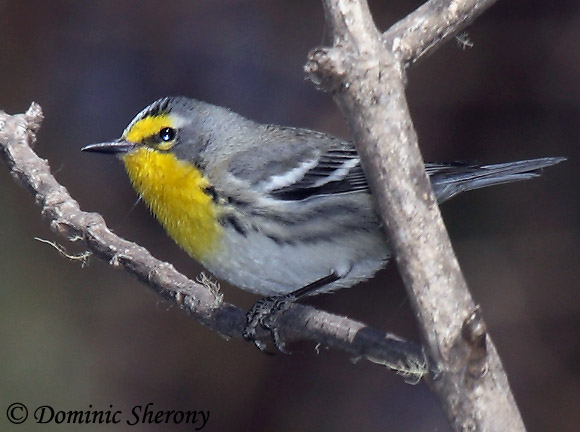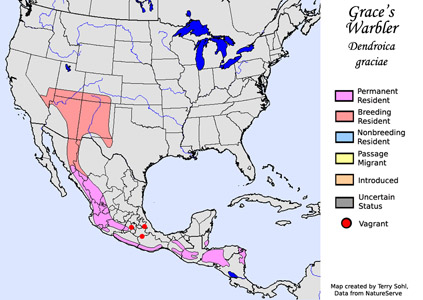| Length: 5 inches | Wingspan: 8 inches | Seasonality: Non-resident in South Dakota |
| ID Keys: Yellow face and thraot, dark gray upperparts, white underparts, darker streaks on flanks | ||
 The
Grace's Warbler is a summer resident in the southwestern U.S., where its
habitat and habits of breeding and foraging high in the canopy of pine
forests make it a species that is often difficult to observe. The
species was named after the sister of 1800s ornithologist Elliott Coues, who
first described the species in 1864.
The
Grace's Warbler is a summer resident in the southwestern U.S., where its
habitat and habits of breeding and foraging high in the canopy of pine
forests make it a species that is often difficult to observe. The
species was named after the sister of 1800s ornithologist Elliott Coues, who
first described the species in 1864.
Habitat: During the summer breeding season, Grace's Warblers are found in forested habitats, usually pine but also sometimes in other evergreens or in mixed evergreen/deciduous forest. During the winter, they are found in mountain pine/oak forests of Mexico.
Diet: Feeds on insects.
Behavior: Spends most of its time high in the forest canopy. Grace's Warblers forage by "flycatching" (flying out from a perch to grab flying insects), clambering on tree branches and foliage, or hovering and gleaning insects from plants. .
Nesting: The nest of a Grace's Warbler is usually constructed on the branch of an evergreen tree. It is built of thin plant fibers, downy plant material, and spider webs. Both the male and female help to feed and raise the young.
Song: Song of the Grace's Warbler is a slow uneven trill that rises in pitch and speed towards the end.
Migration: Summers in the southwestern U.S. and northwestern Mexico. Moves south for the winter, wintering in western and southern Mexico.
Interactive eBird map: Click here to access an interactive eBird map of Grace's Warbler sightings
Similar Species: Yellow-throated Warbler, Magnolia Warbler, Yellow-rumped Warbler
Conservation Status: There are currently no perceived major threats to Cinnamon Hummingbird populations, and the IUCN cites it as a species of "Least Concern".
Further Information: 1) Cornell's All About Birds - Grace's Warbler
2) Audubon - Grace's Warbler
3) Birdzilla.com - Grace's Warbler
Photo Information: February 14th, 2009 - Jalisco, Mexico - Photo by Dominic Sherony - Licensed under Creative Commons Attribution Share-Alike 2.0 Generic license.
| Click below for a higher-resolution map |
 |
| South Dakota Status: Non-resident in South Dakota |
Additional Grace's Warbler Photos (coming soon!!)
